
Features
Hatchery Operations
Research
Restocking
Michigan DNR celebrates 150 years of hatchery history
May 15, 2023 By Ed Eisch and Sierra Williams, Fisheries Division - Michigan Department of Natural Resources
Michigan has a rich history of rearing fish since the state began operating hatcheries 150 years ago. Hatcheries are facilities where fish eggs are hatched, and fish are raised to stocking age. The use of stocked fish has long been one of the cornerstones in managing Michigan’s fisheries, but it has gone through many changes over time.
The need for fish hatcheries
In the early 1800s, Michigan’s landscape was largely covered by old-growth forest. Northern Lower Peninsula streams teemed with Arctic grayling. In Upper Peninsula streams, the beautiful brook trout was king. Lake trout still served as the apex predator in the Great Lakes, but this idyllic scene was about to change.
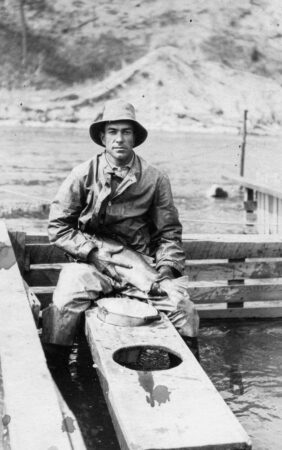
The first Marquette State Fish Hatchery superintendent, Charley Montague, collecting eggs from a female brood fish. (Photo: Michigan Department of Natural Resources)
With the opening of the St. Lawrence Seaway creating a connection between the Great Lakes and the Atlantic Ocean – specifically via the Welland Canal during the 1830s – invasive sea lamprey began arriving in the Great Lakes and would soon begin their assault on native lake trout.
Rapid economic growth in Michigan and beyond would soon require massive amounts of lumber – the primary building material of the day. Environmental protection was not even a concern at the time that the timber harvest industry began to deforest the state at a ferocious pace.
Trees were harvested right up to the edges of streams, resulting in huge amounts of sand being flushed into rivers, threatening fish spawning areas. Logs were floated down streams to get them to lumber mills, scouring valuable trout spawning habitat that had not already been covered by sediment.
All of this took a tremendous toll on the trout populations. Fortunately, the timber industry now employs much more environmentally friendly practices, but those measures did not come into play until long after severe damage had already been done to many of Michigan’s trout streams.
By the 1870s, it was apparent that Michigan’s fish populations were in trouble. In response to decreasing fish numbers and habitat quality, the Michigan Fish Commission was established and the state’s first fish hatchery, Crystal Springs, was opened near Pokagon in Cass County in 1873.
Over the next several decades, many more hatcheries and satellite fish rearing stations were developed across the state. They were often located near railroads, as trains were the primary means of transporting fish to their stocking sites. Fish were moved by the Wolverine, a Pullman car that was specially outfitted for hauling fish around the countryside, including sleeping and dining quarters for those tending to the fish. A replica of the Wolverine can be seen at the Oden State Fish Hatchery Visitor Center near Petoskey.
In the early days of hatchery operations, fish were most often stocked at early life stages (fry and fingerlings) because the means of transporting them dictated that large biomasses of fish could not be efficiently moved across the state.
By the mid-1940s, larger-sized fish known as fall fingerlings and yearlings became the more common rearing target.
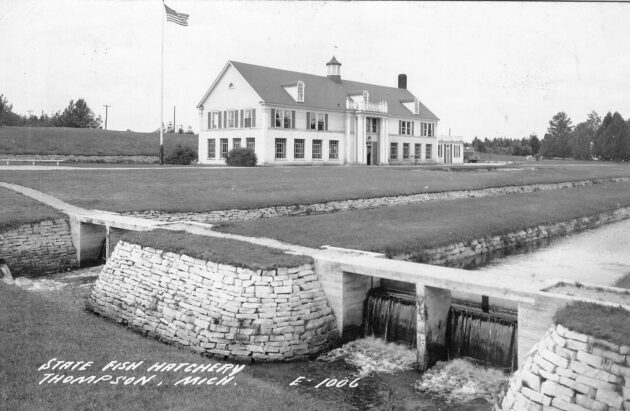
An exterior view of the Thompson State Fish Hatchery from around 1940 (Photo: Michigan Department of Natural Resources)
Lessons learned
From the 1920s through 1940s, the Department of Conservation, predecessor to the Michigan Department of Natural Resources, commonly stocked species such as bluegill, bass and perch. We learned through time that these species were doing just fine on their own.
Beginning in the 1950s, fishery managers pivoted away from stocking these prolific warmwater species and focused more on stocking trout and coolwater species like walleye.
While it is generally known that fish stocked at larger sizes tend to survive better, stocking catchable-sized trout resulted in “truck chasing” from some segment of the fishing community. Newly stocked fish are highly susceptible to fishing, so the practice of stocking catchable-sized fish was discontinued by the mid-1960s.
Fish are stocked for several reasons, including reintroduction of extirpated species, achieving ecosystem balance between predator and prey species, rehabilitation of depressed fish stocks and to provide diverse fishing opportunities.
Where possible, fishery managers strive to rely on natural reproduction to sustain fisheries. However, due to factors such as high fishing pressure, lack of spawning habitat, etc., stocking of hatchery-reared fish is likely to remain a common practice into the foreseeable future.
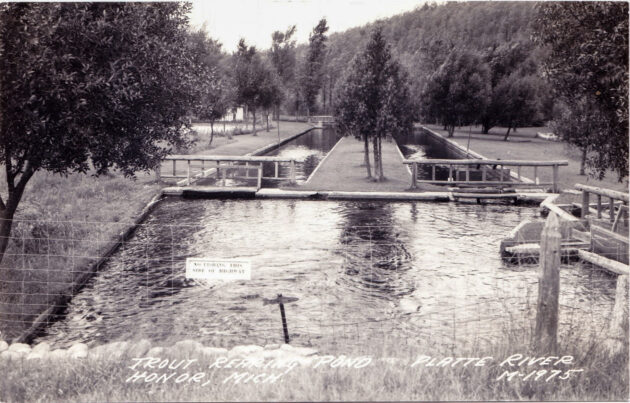
Rearing ponds at the Platte River rearing station are shown, circa 1940. (Photo: Michigan Department of Natural Resources)
Introduction of Pacific salmon
The late 1960s marked a new era of fisheries management in Michigan, as the Pacific salmon stocking program came into being. Coho and Chinook salmon eggs were imported from Pacific Northwest states, with the hope that the resultant salmon populations would staunch the uncontrolled growth of invasive alewives that had rendered many Great Lakes beaches unusable by tourists.
This program proved to be wildly successful, and it served as the impetus to move Michigan DNR hatcheries into the modern era.
The Platte River State Fish Hatchery, located west of Traverse City near the town of Honor, was the first of Michigan’s hatcheries to be rebuilt. It was converted from a satellite trout-rearing station to Michigan’s primary Pacific salmon hatchery.
Thus began the transition from many rearing facilities and hatcheries rearing fish at relatively low densities to only six modern facilities that were designed to rear fish at higher densities.
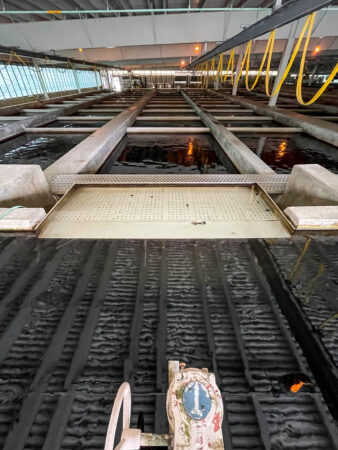
A grow-out raceway at the Platte River State Fish Hatchery (Photo: Michigan Department of Natural Resources)
The switchover to modern facilities with higher targeted rearing densities has been very successful, but it came with its own learning curve and costs. High densities can cause stress for fish, and that can lead to health problems. Over the past 10-15 years, rearing densities have been ratcheted back somewhat to focus more on health and quality, rather than quite so much on quantity. The result is healthier, more robust fish that perform better after being stocked in lakes and streams.
The modern facilities largely rely on pumped well water that gets reused multiple times and must be re-aerated between uses. That means these facilities are reliant on complex mechanical systems, maintained by highly trained staff. The operation of the facilities is tracked by state-of-the-art monitoring and alarm systems that are designed, programmed and maintained by a crew of highly skilled equipment technicians.
With hatcheries that are reliant on mechanical systems, there are always improvements and upgrades that need to be made. The Michigan DNR was fortunate to receive a US$30 million appropriation in fiscal year 2023 to be used to catch up on the backlogged maintenance needs at all six hatcheries and to make energy-efficiency improvements that will keep these facilities operating effectively long into the future.
In all, the Michigan DNR currently operates six fish hatcheries, five permanent egg-take stations and up to 40 rearing ponds. In addition to the permanent egg-take stations, the DNR collects eggs and sperm from natural spawning runs of walleye, lake sturgeon and muskellunge.
Marquette State Fish Hatchery
Located in the north-central Upper Peninsula, Marquette State Fish Hatchery had a partial renovation completed in 1994. This included construction of a new incubation and early fish rearing building. The raceways are still the same as those in place several decades earlier, but they were enclosed by a roofed structure several years prior to the 1994 renovation. Marquette serves as the brood and sole production facility for all the char species stocked by Michigan’s fishery managers. The Arctic grayling brood fish are also held at Marquette. The rearing program includes brook trout, lake trout and the hybrid splake, which is a cross between female lake trout and male brook trout.
Thompson State Fish Hatchery
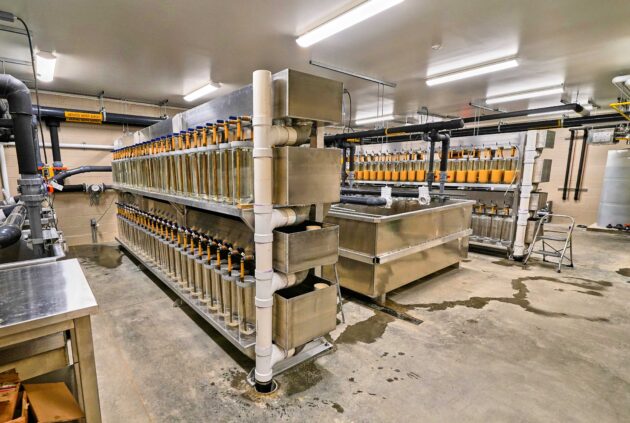
Walleye eggs being incubated in the new coolwater production facility at Thompson State Fish Hatchery. (Photo: Michigan Department of Natural Resources)
Thompson State Fish Hatchery is located a few miles west of the Upper Peninsula town of Manistique. The rearing program there has included Chinook salmon, steelhead, Atlantic salmon, brown trout and rainbow trout in the years since the facility’s rebuild in 1976. Thompson also served as a walleye incubation and hatching station. In 2021, a new coolwater production facility was constructed at Thompson, adding muskellunge and spring fingerling walleye production to the rearing program. The coldwater species currently reared at Thompson include Chinook salmon and steelhead.
Oden State Fish Hatchery
Oden State Fish Hatchery has been in operation since 1921. Over the years, Oden has reared brook trout, brown trout, rainbow trout, Arctic grayling and coho salmon. Having been fully rebuilt in 2002, Oden is the most recently modernized Michigan hatchery. The rebuild included construction of an incubation and early rearing building, 12 enclosed concrete raceways, a brood stock rearing building that includes 20 concrete raceways, some of which are under light control manipulation to adjust the timing of fish spawning, and five 12-inch production wells. The new construction also included an isolated rearing facility that is spatially removed from the rest of the hatchery for use when new stocks are brought into the system. This is currently being used for isolated rearing of future brood stock Arctic grayling. The original hatchery building from the 1921 construction was converted into the visitor centre in 2004. Oden’s current rearing program includes both brood and production fish for the brown trout and rainbow trout stocking programs.
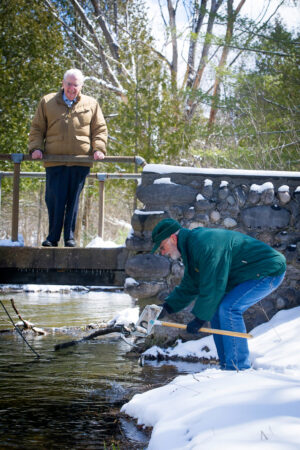
The 50th Anniversary celebration honouring Dr. Howard Tanner, who was the driving force that introduced salmon to the Great Lakes. Platte River State Fish Hatchery, Beulah, Mi. (Photo: Michigan Department of Natural Resources)
Platte River State Fish Hatchery
Platte River State Fish Hatchery was fully rebuilt in 1975 and underwent a partial renovation that was completed in 2004. The current rearing program at Platte includes Chinook salmon, Atlantic salmon and 100% of the coho salmon produced by the DNR. Platte also incubates and hatches walleye eggs each spring.
Harrietta State Fish Hatchery
Harrietta State Fish Hatchery is located about 13 miles west of Cadillac, just outside of the village of Harrietta. The longest continually operating hatchery in Michigan, Harrietta was originally put into service in 1901. Over the years, brook trout, brown trout and rainbow trout have been reared there. A full hatchery renovation was completed in 1978, which included a new hatchery and incubation building, installation of four large production wells and 12 concrete raceways and eliminating the use of several ponds that were located across the road from where the hatchery sits today. The rearing program at Harrietta now includes brown trout, rainbow trout and Atlantic salmon.
Wolf Lake State Fish Hatchery
Wolf Lake State Fish Hatchery underwent a total renovation that was completed in 1982. This renovation included construction of a new hatchery and early rearing building, as well as 12 new concrete outdoor raceways. A standalone visitor center was also built as part of this renovation. Wolf Lake has four lined rearing ponds used for coolwater species, as well as several earthen ponds. Over the years, Wolf Lake has reared many different species, including Arctic grayling, lake sturgeon, brown trout, Atlantic salmon, Chinook salmon, walleye and muskellunge. Prior to the renovation, the earthen ponds were used to produce warmwater species such as bass and bluegill. The current rearing program at Wolf Lake includes muskellunge, walleye, steelhead and Chinook salmon.
In an average year, the Michigan DNR stocks 20-25 million fish at up to 1,000 stream, inland lake and Great Lakes sites to support fish populations throughout the state.
Print this page
Advertisement
- Industry movers and shakers awarded at Aquaculture Ghana 2023
- Pre-treatment of R. okamurae enhances diet suitability in juvenile European sea bass





